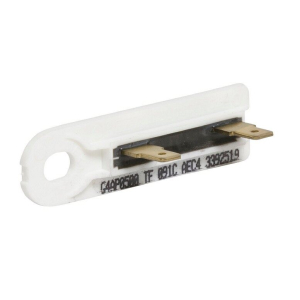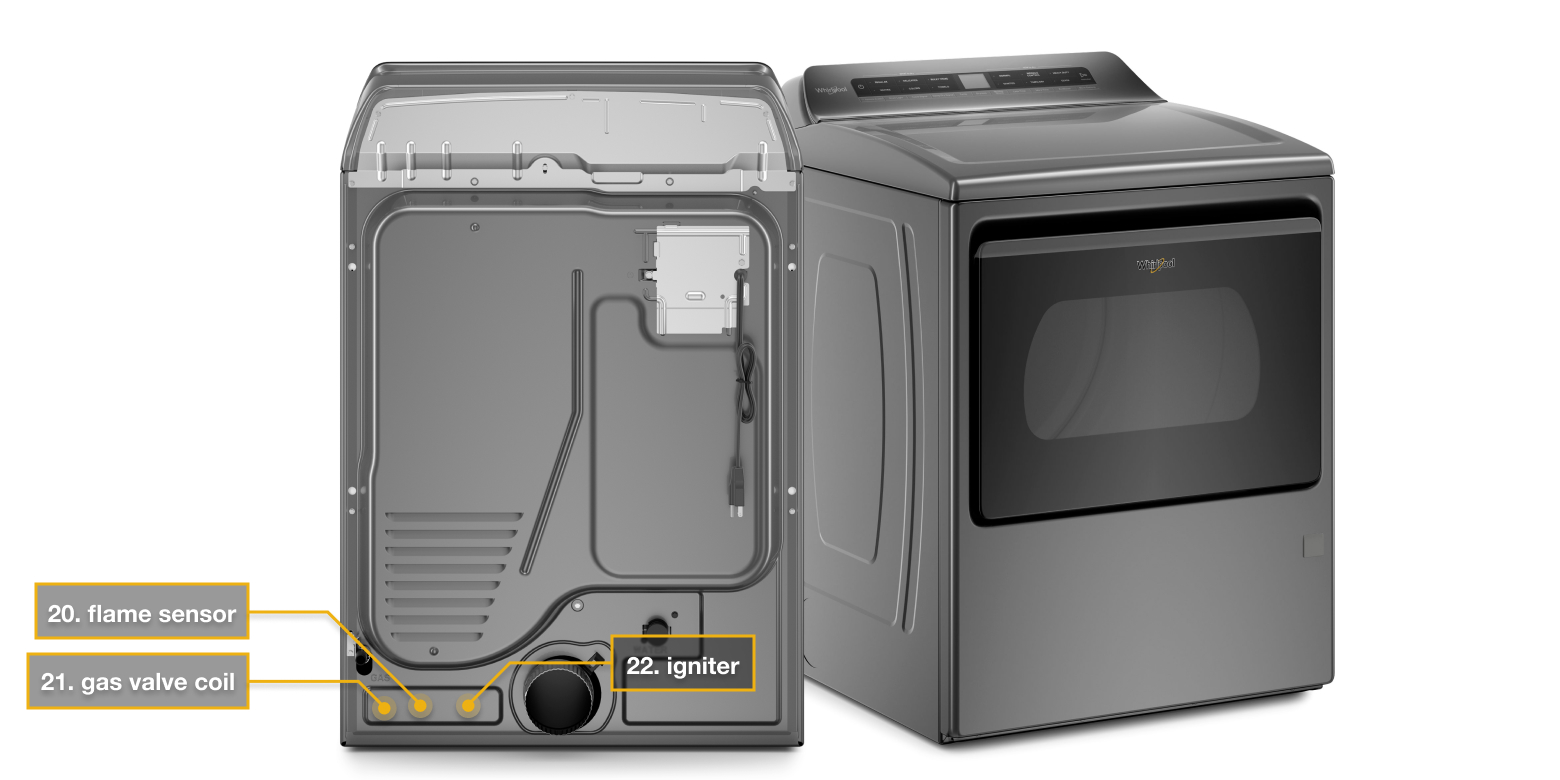
What are the parts of a dryer?
Your dryer keeps laundry day running smoothly to ensure your clothing is ready to wear, but you may not be familiar with how it works or how to fix a dryer. Get to know your dryer inside and out by learning more about the parts. This guide will give you information on parts, their location and maintenance tips.
Parts of a dryer: A quick guide
All dryers use a combination of heat, air and drum rotation, which are necessary for proper dryer operation. Understanding your dryer may help you keep it running smoothly.
Select a link below to learn more about the function of the external parts, internal parts or gas vs. electric parts. You can use the dryer parts diagram to get an idea of where basic parts are located. Exact locations may vary from top to front load machines, as well as model to model.
Internal Dryer Parts



10. Dryer blower
The dryer blower circulates air by pulling dry air in and drawing hot damp air out through the vent. It is located near the bottom of the dryer cabinet. If you hear high-pitched noises during use, loud vibrations or experience longer drying times, these may be signs to replace your blower.
Shop Whirlpool®dryer blower

11. Dryer thermal fuse
The dryer thermal fuse works as a safety mechanism to prevent your dryer from overheating. If it overheats, the thermal fuse will blow and cut off power to the motor. Once a fuse is blown and the dryer doesn’t heat, it can’t be reset.
Shop Whirlpool® dryer thermal fuse

12. Dryer sensor and thermistor
Typically located on the blower housing, the dryer temperature sensor(s) monitor the cycle temperature to dry your laundry. If your clothing is not drying completely during an auto cycle, the moisture sensor strip may need to be cleaned or replaced.
Shop Whirlpool® dryer sensor and thermistor

13. Dryer idler pulley wheel
The idler pulley wheel provides tension for the drive belt to help rotate the dryer drum. It’s located in the back panel of the dryer and may make a high-pitched squealing or rattling noise when malfunctioning.
Shop Whirlpool® dryer idler pulley wheel

14. Dryer drive belt
The drive belt wraps around the outside of the dryer drum. It’s connected to the drive motor to rotate the drum during a drying cycle. If the drum doesn’t rotate, but the motor can be heard, it might be time for a new drive belt.
Shop Whirlpool® dryer drive belt

15. Dryer drive motor
Located in the back panel of the dryer, the drive motor sends power to the pulley wheel and the drive belt to rotate the drum. If the dryer doesn’t start, makes a loud noise or stops mid-cycle, the motor may be the issue.
Shop Whirlpool® dryer drive motor

16. Dryer drum slide, glide or pad
The drum slides, glides or pads are inside the dryer cabinet and support the drum as it rotates. The dryer will make a loud sound when the slides need replacement. You may need to replace all slides at once as they typically wear out simultaneously.
Shop Whirlpool® dryer drum slide, glide or pad

17. Dryer drum roller
The drum rollers are in the back panel near the drum. They hold the drum in place during a drying cycle. If the dryer makes a loud rumbling noise during use, you may need to change the drum rollers. Some drum rollers are known to be loud at the start of a cycle and once they "warm up" the sound goes away. Rollers typically wear out at the same time, so consider changing all the rollers at once.
Shop Whirlpool® dryer drum roller

18. Dryer circuit board and timer
Located in the back panel, the dryer electronic control board manages the settings, such as the time, temperature and function. It directs power to the motor and other components. If all other components of the dryer are functioning properly but the dryer still won’t run, it might be the control board causing the malfunction.
Shop Whirlpool® dryer circuit board and timer

19. Dryer heating element
Electric dryers have a heating element that is a coil or wire to heat the air circulated by the blower in the dryer drum. It’s either behind the dryer drum or in the back panel of the appliance. If the dryer doesn’t heat during a cycle, that may be the source of the problem.
Shop Whirlpool® dryer heating element
Gas vs. Electric Parts
Though many parts of a dryer are the same whether your appliance is gas or electric, gas dryers have a few additional components as they use a different fuel source.



20. Flame sensor
In a gas dryer, the flame sensor detects when the igniter is ready to light the In a gas dryer, the flame sensor detects when the igniter is ready to light the gas burners. The sensor is located across from the flame igniter. If the sensor is broken, the dryer will not heat.
Shop Whirlpool® dryer flame sensor

21. Gas burner and control valve
A gas dryer will use a gas valve coil located near the flame igniter to heat the dryer by opening the flame ignition. Dryers that don’t heat or heat up intermittently may need a coil replacement.
Shop Whirlpool® dryer gas burner and control valve

22. Dryer igniter
Located on the side of the gas burner in a gas dryer, the dryer igniter lights the gas to heat the dryer. If defective, the gas will not ignite to heat the dryer.
Shop Whirlpool® dryer igniter
External Dryer Parts



1. Dryer feet
The dyer feet are on the bottom of the appliance. They help keep the dryer firmly in place. If the dryer is vibrating and off balance during a dry cycle, the feet may not be level or functioning properly.
Shop Whirlpool® dryer leg, foot and caster parts

2. Dryer light bulb
When you open the dryer door, you’ll notice a light bulb turn on. This bulb illuminates the dryer’s interior. If the bulb is burnt out, it’s usually easy to replace it.
Shop Whirlpool® dryer light bulbs

3. Dryer lint filter
Depending on the model, the lint filter is located either on the exterior of the dryer or the inside door opening. It collects lint and debris as it passes through the dryer vent. The lint filter should be cleaned after each dry cycle. If your clothes are still damp after a cycle, try washing it with soap and water.
Shop Whirlpool® dryer lint filters

4. Dryer knob or dial
Located on the exterior of the dryer, the knob or dial is used to select the time. If you’re not able to turn it, or if it turns but isn’t responding, it may be time for a new knob or dial.
Shop Whirlpool® dryer knob or dial

5. Dryer door seal
The dryer door seal closes the gap between the dryer drum and the door to prevent air and loose items from passing through. If the dryer door isn’t closing properly, the seal may need to be replaced.
Shop Whirlpool® dryer door seal

6. Dryer door latch
The latch keeps the dryer door shut during a dry cycle. If the dryer door is not closing or pops open, you won’t be able to use the dry cycle.
Shop Whirlpool® dryer door latch

7. Dryer door switch
Located in the opening of the dryer door, the dryer door switch stops the dryer function when the door is ajar. If the dryer doesn’t start when the door is closed, there may be an issue with the switch.
Shop Whirlpool® dryer door switch

8. Dryer baffles
The dryer baffles are located in the interior of the dryer drum. They promote air flow to help tumble laundry during the dryer cycle. If a baffle is loose or has fallen off, it needs a replacement part.
Shop Whirlpool® dryer baffle

9. Dryer vent
The dryer vent on the back of the dryer expels the damp hot air from the dryer to the outside of your home. Cleaning it once every two years or more, depending on dryer use, and the length and number of bends in the dryer vent, will keep the vent functioning properly.
Shop Whirlpool® dryer vent


Gas dryer vs. electric dryer parts
Both gas and electric clothes dryers require electricity to run, but gas dryers also require a gas hookup to generate heat. An electric dryer requires a 220V outlet, while a gas dryer will need a 110V outlet.The main difference between the two is how they heat the airflow to dry your laundry. Gas dryers use natural gas or propane to generate heat and electricity to power the drum, fan, lights and controls. Electric dryers use metal heating coils and are completely powered by electricity.
Gas and electric dryers from Whirlpool brand offer comparable performance, innovation and convenience – and a variety of sizes/capacities and styles. Check the hookup in your home to find the right dryer for you.
What are the parts of a dryer drum?
What is a dryer drum? It’s the cylindrical part of the dryer and has baffles that lift and circulate the clothes. A drive pulley and idler pulley rotate the drive belt that wraps around the drum. The drum is supported by slides, glides or pad. A felt drum seal secures the clothing inside the drum.


What is a top load dryer?
While you may see certain models called “top load” dryers, they don't actually load from the top. They are meant to pair with a top load washing machine for a matching aesthetic. Both top load and front load dryers load in the front.
What are dryer arms?
The arm of a laundry dryer connects the idler pulley wheel to the motor. The idler pulley wheel creates tension on the drive belt around the drum. It helps rotate the dryer drum to spin the clothes dry. A worn or broken arm will interrupt the dry cycle as it will impede the rotating drum. Learn about more reasons a dryer might stop spinning.
Where to buy parts for a dryer?
If you’re the owner of a Whirlpool® dryer and you’re having trouble with some of the components, then you should only use Whirlpool-specific parts with your dryer. Using other parts that aren’t Whirlpool brand may damage your machine.
For replacement parts for Whirlpool® dryers, you can find everything you need on the Whirlpool® dryer parts and sccessories page.
Shop the latest deals on select Whirlpool major appliances Shop Now
Shop Whirlpool® dryers
Do you need a new dryer? Both gas and electric dryers from Whirlpool brand are convenient and have optimal functionality to keep laundry day on track. Find the dryer that works best for your home.
Discover more from Whirlpool Brand


home heartbeat
Ready for more tips, home hacks and appliance guides?
Was this article helpful? Pass it on
1. Some dryer models do not include a light bulb inside the dryer opening.

